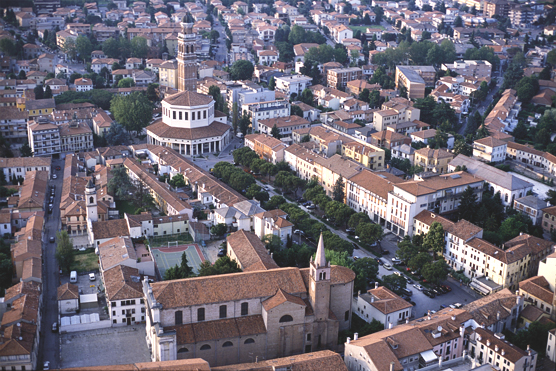ROVIGO: THE PROVINCE
The Province of Rovigo borders with:
- the Provinces of Venice, Padua and Verona to the north;
- the Province of Ferrara to the south; and
- the Adriatic Sea to the east.
Back to top
GEOGRAPHY – THE “POLESINE”
The territory between the final lengths of the Adige and Pò Rivers is known as the Polesine. Already in the times of the Republic of Venice, this area was known as the breadbasket of the Veneto. Today it is one of the richest agricultural areas of Italy.
“This is a narrow land between two majestic shores of the two great Italian Rivers; this is a land where toil, the struggle for survival and tenacity have been, for thousands of years, the rules for working people of strong and proud spirit. It is the Polesine, not a common land; a land that must be first known and understood in order to be appreciated.”
One can say that the Polesine came from the water. The Adige and Pò Rivers have transformed this region by continuously adding to it as they transport silts, sands and rock towards the sea. It is an orderly and fertile plain, full of farmland and trees and carved by rivers and canals. It has excellent area for hunting and fishing. The Polesine “Valli” (see below) are, in fact, replete with excellent species of fish such as the cefalo, the orata, sole and eel.
The Polesine is also famous for the art of inlaid woodworking and wood sculpting. Inlaid woodworking is a type of mosaic made with pieces of wood of different species and sizes. They are laid side by side to form all manners of designs.
Back to top
THE GREAT RIVERS: THE PÒ AND THE ADIGE
The Pò reaches the Polesine are to the east of Ostiglia and further ahead it divides into many smaller branches. Afterwards begins the delta of the Pò River, which covers a territory of 400 square kilometres. It is like a fan of waterways. Near the open sea, the Pò Delta is an intricate area of water pools called “Valli”. Some of these “Valli” have salt water and some have fresh water. These “Valli” are defined by long strips of land and are the realm of those who carry a passion for hunting and fishing.
The Adige River, once it reaches the Polesine area, travels parallel to the Pò River for over 50 kilometres and spills into the sea just south of Chioggia.
Back to top
A TOUR OF THE PROVINCE OF ROVIGO
Adria: This was a powerful Etruscan colony. It had many ties with Greece and diffused much of that culture and civilization in the Pianura Padana (the plains of the Province of Padua).
Fratta Polesine: Here we find Villa Badoer, a creation of the famous architect, Palladio.
Lendinara: A centre for processing beets and hemp. It has an artistic Palazzo Comunale (Town Hall) and a beautiful Duomo (church) adorned with precious paintings.
Badia Polesine: An agricultural and commercial centre with the Palazzo degli Estensi, now a hotel.
Arquà Polesine: This tow has an ancient castle reconstructed by the Estensi
Loreo: At the centre of an area reclaimed from swampland.
Porto Tolle: The largest agricultural and industrial town of the Province.
Back to top
ROVIGO CITY, CAPITAL OF THE PROVINCE
Rovigo City is the capital of the Polesine (see above). It is found on the plains on the shores of the Adigetto River, between the Adige and Pò Rivers. It is a typical city of the Veneto Region shaped like a pentagon. It is characteristic for its towers, steeples and ancient plazas. It is also an important agricultural and industrial centre.
Back to top
THE HISTORY OF ROVIGO CITY
As demonstrated by urns, coins and clay containers found in the region, Rovigo City is of Roman origin. Its original name was “Rhodigium”, a name that is derived from the Greek word for “Rose”.
With the fall of the Roman Empire, Rovigo City is spared from the barbaric invasions thanks to the swamplands that surround it.
From 1194 to 1482, the Estensi family from Ferrara rules the City. It then passes under the rule of the Republic of Venice and therefore follows the exploits of the Serenissima for several centuries. This is a period of splendor for Rovigo City: it dries up the swamplands, expands and adorns itself with beautiful buildings and churches.
From 1797, with the fall of the Republic of Venice, Rovigo City falls under the dominion of the Francesi family for a period of time and then under Austrian rule for a much longer period of time.
In 1866, Rovigo City is liberated and reunited with the rest of Italy.
Back to top
PRINCIPLE MONUMENTS AND BUILDINGS
In Piazza Vittorio Emmanuele II, there is the famous Column with the Lion of St. Mark perched on top. It is a symbol of the Serenissima (the Republic of Venice) to which Rovigo was an ally for many centuries. In the Piazza there is also the City Hall, the Palazzo Roncale, one of the more impressive buildings of Rovigo City and the Palazzo dell’Accademia dei Concordi, the home of two important libraries and an Art Gallery containing noted works of Veneto painters such as Piazzetta, Longhi, Giambellino and Tiepolo.
In Piazza Matteotti, two leaning towers rise. Torre Donà, is one of the tallest towers in all of Italy and Torre Mozza is part of the remains of the castle that was built to defend Rovigo City.
Some interesting churches include: the Duomo, containing famous paintings; the Church of the Beata Vergine del Soccorso also known as “The Rotonda”, dedicated to the Madonna that grants graces; the church of San Francesco; the church of San Bartolomeo.

